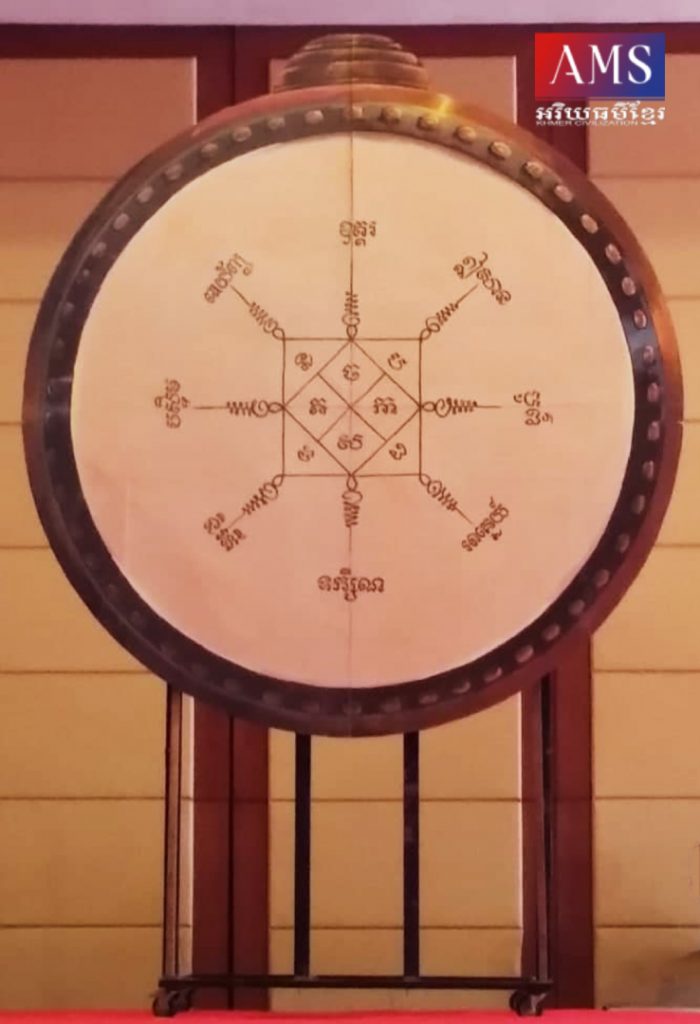ប្រទេសកម្ពុជាមានស្គរច្រើនប្រភេទរួមមាន៖ ស្គរមហោរធឹក ស្គរភ្លៀង ស្គរអារក្ស ស្គរដៃ ស្គរដី ស្គរថូន ស្គររមនា ស្គរឆៃយ៉ាំ ស្គរយីកេ ស្គរយោល ស្គរភ្លោះ ស្គរឈ្នះ (ក្លងឆ្នាក់) ស្គរបាសាក់ ស្គរឡុក ស្គរកាណាំង (ស្គរចាម) ស្គរព្រៃ ស្គររបាំទន្សោង ស្គរប៉ុយ សម្ភោរ ស្គរធំ ស្គរភេរី ស្គរជ័យ និងស្គរយាម។ល។
ស្គរមហោរធឹក មានវត្តមានតាំងពីសម័យបុរេប្រវត្តិសាស្ត្រមកម៉្លេះ ដែលគេរកឃើញ នៅក្នុងតំបន់អាស៊ីមានប្រទេសចិន វៀតណាម ឡាវ ថៃ និងខ្មែរ។ នៅកម្ពុជា ស្គរមហោរធឹក មានប្រើនៅក្នុងព្រះបរមរាជវាំងរហូតដល់ដើមឆ្នាំ១៩៧០ នៅក្នុងព្រះរាជពិធី ដូចជាព្រះរាជា ភិសេកព្រះមហាក្សត្រជាដើម នៅក្នុងក្បួនដង្ហែដែលមានអ្នកសែងស្គរបួននាក់ និងអ្នកវាយ ស្គរម្នាក់។ ស្គរមហោរធឹកមួយចំនួនដែលដាក់តាំងនៅសារមន្ទីរជាតិ ក្រុងភ្នំពេញសព្វថ្ងៃ មានរាងធំ ហើយទាបស្រដៀងគ្នានឹងត្បាល់បុកស្រូវឬឆ្នាំងធំបុរាណដែលគេដាក់ផ្កាប់។ ស្គរមហោរធឹកធ្វើពីសំរឹទ្ធ ស្ពាន់ ឬទង់ដែង ដោយមានរន្ធក្រវិលត្រចៀកសម្រាប់ចងឬ ថ្ពក់សែងផង។
ស្គរភ្លៀង ឬស្គរសុំទឹកភ្លៀង ជាប្រភេទស្គរបុរេប្រវត្តិសាស្ត្រដូចជាស្គរមហោរធឹកដែរ គ្រាន់តែមានរាងស្គមតូចជាងស្គរមហោរធឹក។ នាសម័យបុរាណ គេប្រើស្គរភ្លៀងសម្រាប់ ហៅឬសុំទឹកភ្លៀងនៅពេលមានភាពរាំងស្ងួត។ ក្នុងន័យនេះ គេមានឆ្លាក់រូបកង្កែបតូចៗ នៅពីលើគែមជុំវិញមុខស្គរ ជាតំណាងឱ្យការសប្បាយរីករាយនៃសត្វកង្កែបនៅពេលមាន ភ្លៀងធ្លាក់ក៏ដូចជាការទទួលបាននូវទឹកភ្លៀង។
ស្គរភេរី៖ «ភេរី» មកពីភាសាបាលី, ភេរិ មានន័យថា «ស្គរធំ»។ ឯ ភេរីចរ មានន័យថា «ការត្រាច់ចរតាមផ្លូវដោយការវាយស្គរ»។ ស្គរភេរី មានតួនាទីសំខាន់នៅតាមវត្តអារាមខ្មែរ សម្រាប់ទូងប្រកាសដំណឹងដល់ព្រះសង្ឃនិងពុទ្ធបរិស័ទ ជាពិសេសវត្តអារាមនៅតាមទីជនបទស្រែចម្ការ។
គេប្រើស្គរភេរី ដើម្បីប្រាប់ពីពេលវេលាប្រជុំឬជួបជុំគ្នាក្នុងពិធីសំខាន់អ្វីមួយ។ គេក៏ទូងស្គរភេរី សម្រាប់ជូនដំណឹងដល់អ្នកស្រុកឱ្យប្រញាប់ប្រញាល់រៀបចង្ហាន់ថ្ងៃត្រង់ប្រគេនព្រះសង្ឃដើម្បីឆាន់ទាន់ពេល គេហៅថា៖ ស្គរ១ ស្គរ២ ស្គរ៣ ដែលគេសន្មតគ្នាកំណត់យកសញ្ញាតាមភូមិនីមួយៗ គឺ៖
ស្គរ១ = ឱ្យដំណឹងលើកទី១
ស្គរ២ = បញ្ចប់ការរៀបចង្ហាន់ប្រគេនព្រះសង្ឃ
ស្គរ៣ = ព្រះសង្ឃឆាន់ហើយ
យើងក៏គួរកត់សម្គាល់ផងដែរថា សព្វថ្ងៃនេះ វត្តមួយចំនួនមិនមានប្រើស្គរភេរីទេ តែគេប្រើជួងឬរគាំងជំនួសវិញ ដើម្បីផ្តល់ជាសញ្ញាជូនដំណឹងដល់ប្រជាជនក៏ដូចជា ឧបាសកឧបាសិកានៅក្នុងភូមិនិងចំណុះជើងវត្ត។
ខ្លះហៅស្គរភេរីថា «ស្គរជ័យ» ព្រោះមានតួនាទីសម្រាប់ដាស់ស្មារតីកងទ័ពឱ្យរំភើបអង្គអាចក្លាហានក្នុងពេលចេញច្បាំង ឬបន្លឺសូរឱ្យកងរំពងនៅពេលត្រឡប់មកពីសមរភូមិវិញ ប្រកបដោយជោគជ័យ។ នៅលើស្បែកស្គរជ័យ គេមានគូរយ័ន្តមន្តអាគមគាថាផង។ នៅក្នុងក្បួនដង្ហែទ័ព ដើម្បីប្រារព្វរំព្ញកនៃជ័យជំនះ គេទូងស្គរជ័យឲ្យឮសូរខ្លាំងនិងមានភាពអធឹកអធមដែរ។
ស្គរធំមួយប្រភេទទៀត គេហៅថា «ស្ករយាម» គឺគេទូងដើម្បីផ្តល់ដំណឹងពីពេលវេលា ដោយនាបុរាណកាល យើងមិនមាននាឡិកាដូចសព្វថ្ងៃសម្រាប់ប្រើប្រាស់ប្រាប់ពីពេល វេលានៅឡើយ។
នាបច្ចុប្បន្នកាល ដូចជាក្នុងសម័យកូវីដ-១៩ យើងប្រើស្គរធំ រួមជាមួយនឹងឧបករណ៍ ឯទៀត មានគង ជួង រគាំង ជាដើម សម្រាប់បញ្ជូនសាររំព្ញក ពញ្ញាក់ស្មារតី និងបណ្តេញ គ្រោះឧបទ្រពចង្រៃឱ្យវិនាសចេញឆ្ងាយ ដើម្បីបានសិរីសួស្តីជ័យមង្គលចូលមានដល់ ប្រជាជនខ្មែរទូទាំងប្រទេស ក៏ដូចជាប្រជាជនទូទាំងពិភពលោកទាំងមូល។
————————————————————
Skor Thomm or Large Barrel Drums in Cambodia
Drums in Cambodia are ubiquitous. They include skor mohorathoeuk (bronze drum), skor phlieng (rain drum), skor arakk, skor dai, skor dey, skor thaun, skor rumanea, skor chhaiyaim, skor yike, skor yol, skor phluoh, skor chhneah, skor basakk, skor lokk, skor kanaing, skor prey, skor robaim tunsaong, skor poy, sampho, skor thomm, skor pheri, skor yeam, and so on.
Skor Mohorathoeuk is a prehistoric bronze drum uncovered in many parts of Asia: China, Vietnam, Laos, Thailand, and Cambodia. In Cambodia, skor mohoratheouk had been used at the royal court until the beginning of 1970 in royal ceremonies, namely, the crowning and royal wedding. Another type of prehistoric bronze drum, skor phlieng or rain drum, is similar to skor mohoratheouk but slimmer. It was used to call for rain during a drought. For this reason, on the edge and around the drum head, images of little frogs were attached, symbolizing the rainfall as well as the playfulness of the frog. A number of the prehistoric bronze drums, made of alloy, brass, bronze, or copper, are on display at the National Museum in Phnom Penh.
Skor Pheri refers to large barrel drum type, mainly used at the monastery to signal the local Buddhist practitioners, for instance, of an important gathering or lunch-time food offering to monks. Some call skor pheri, skor chey or victory drum instead for its use in the encouragement of the army to be brave and courageous in the battlefield. It is also used to felicitate the victory of the army returning from the battlefield. For such a purpose, there are magical yantras drawn directly on the drum head. Likewise, on a Victory Day or its anniversary celebration, such a drum is beaten loudly to mark its significance and to deem it glorious and celebratory. Yet, another type of large barrel drum is called skor yeam; it is used to tell time, as in the olden days, there were no clocks or watches.
During the Covid-19 pandemic period, large barrel drums, along with other instruments, namely, large gongs, large bells, and large sound-producing metal pieces are beaten and struck loudly to send a message and reminder of vigilance, awareness, carefulness, and caution of the deadly disease as well as to ward off evil spirits in order to bring blessing, good health, and happiness to all Cambodians and peoples of the world over.
អត្ថបទដើម៖ បណ្ឌិត សំ សំអាង







